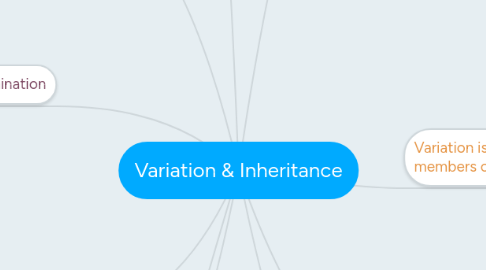
1. Chromosomes, Genes & Alleles
1.1. Genetic information is found in the nucleus of the cell
1.2. Chromosomes are divided up into genes, and genes are made of DNA
1.3. Genes are packets of information stored along chromosomes
1.4. Alleles
1.4.1. Alleles are the different forms of the same gene
1.4.1.1. Example: Blue eyes and Brown eyes
1.4.2. For each gene we have 2 alleles
1.4.3. We receive one allele from each parent
1.4.4. Dominant & Recessive Alleles
1.4.4.1. Dominant
1.4.4.1.1. A dominant characteristic hides the other characteristic (it always overpowers a recessive allele)
1.4.4.1.2. Represented by an uppercase letter e.g. A
1.4.4.2. Recessive
1.4.4.2.1. A recessive characteristic is the characteristic that is masked
1.4.4.2.2. Represented by a lower case letter e.g. a
2. Phenotypes & Genotypes
2.1. Phenotype is the appearance of an organism
2.1.1. Examples: Blue eyes, Brown hair
2.2. Genotype is the set of alleles that an organism posesses
2.2.1. Examples: BB, Bb, bb
3. Homozygous & Heterozygous Individuals
3.1. Homozygous is when there are two of the same alleles (e.g. AA or aa)
3.2. Heterozygous is when there are two different alleles (e.g. Aa)
4. Genetic crosses
4.1. Parents = P
4.2. Children = F1
4.3. Grandchildren = F2
4.4. A monohybrid cross is a cross involving one characteristic
4.4.1. The expected F2 ratio of a monohybrid cross is 3:1
4.5. Ratios
4.5.1. Actual observed ratios are different to predicted or expected ratios because fertilisation is a random process involving an element of chance
5. Genetic Determination
5.1. The father's sperm determines the sex of the baby as he can pass on either an X or Y chromosome whereas the mother only has X chromosomes to pass on
5.1.1. X = Female
5.1.2. Y = Male
6. Mutations
6.1. Mutations are spontaneous changes to chromosome structure or the number of chromosomes
6.1.1. This is the only source of new alleles
6.2. Mutagenic Agents can cause mutations
6.2.1. Examples: Radiation (e.g. x-ray or UV rays), High Temperatures and Chemicals (e.g. mustard gas)
7. Inheritance
7.1. This is the study of genetics and its transmission from generation to generation
8. Genetics
8.1. This is the study of inheritance and variation
9. Variation is the differences between members of the same species
9.1. Sexual Reproduction leads to variation - the combining of different genes contributes to variation within a species
9.1.1. 50% of the father's and 50% of the mother's genetic information is passed on
9.2. Variation is important for the survival of the species so it can adapt to a changing environment
9.3. Continuous and Discrete Variation
9.3.1. Continuous
9.3.1.1. Variation which can be measured
9.3.1.2. Examples: Height, Weight, Handspan, Hair length
9.3.1.3. Many genes control the variation (polygenic inheritance)
9.3.1.4. Represented using a line graph
9.3.2. Discrete
9.3.2.1. Variation which can be grouped
9.3.2.2. Examples: Eye colour, Hair colour, Male/Female, Ear lobes/Lobeless
9.3.2.3. A single gene controls the variation
9.3.2.4. Represented using bar graph
10. Genetic Councelling
10.1. A pedigree chart is used to study the genetics within families
10.2. A Genetic Carrier is a person who has one copy of a disease allele but is not affected by the disease
10.3. Steps involved in Genetic Councelling
10.3.1. 1. Information gathering
10.3.2. 2. Diagnosis
10.3.3. 3. Risk assessment
10.3.4. 4. Information giving
10.3.5. 5. Psychological assessment and counselling of parents
10.3.6. 6. Help with decision making
10.3.7. 7. On going client support
